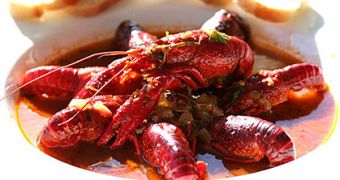1.Crayfish is a freshwater variant of the lobster. In Europe, their meat is highly appreciated. In Europe, the first producer is Norway, whereas the first consumer is France. What is consumed from the crayfish is the meat from the abdomen and claws.
2.These crustaceans have a good eyesight and, like other related species, they can move their eyes independently from one another.
3.Crayfish molt at the end of June. They usually eat their old skeleton in order to recover the calcium and phosphates contained in it. In fact, on the sides of their stomach, crayfish have two limestone grains, filtered from the water, which serve for impregnating the new forming skeleton with calcium.
4.These crustaceans eat plant material, but also snails, clams, insect larvae, small fish and carrion.
5.Crayfish walk forward; they move backward only when swimming with their abdomen movements. Still, swimming backward is much more rapid.
6.Adult size is reached by crayfish in the wild in about 4 years. They can live from 20 to 30 years.
7.During the breeding season, males fight for the right to copulate and, in these competitions, they may lose a leg or claw. This is no problem, as they will slowly grow back.
8.The sperm of crayfish is highly unusual: it is totally devoid of flagella (tails). It looks like amoebas and crawls towards the eggs.
9.Besides humans, water birds, pikes and eels indulge on crayfish. They are also extremely sensitive to diseases like crayfish pest and plague.
10.In 1974, the red swamp crayfish (Procambarus clarkii) was introduced from southeastern US into Europe. This species carries a water mold, Aphanomyces, to which it is immune, but at the contact of which, the indigenous crayfish of Europe, Astacus and Austropotamobius, die in a few weeks. This way, the American crayfish has eliminated countless populations of European crayfish.
While the local species mainly eat detritus (organic wastes), keeping a clean water environment, the red one wipes out everything: fish eggs, hatchlings and algae; it also digs deeper into the banks, causing erosion, and has a more rapid development than the local species. Moreover, the red crayfish result tasteless for the European consumers, who are losing a valuable commercial species this way.
The species was also introduced in some African areas, where it decreased fish production. Moreover, Africans do not have a tooth for crayfish.
11.The presence of crayfish in the water is a sign of lack of severe contamination. Crayfish cleanse the water of detritus and carrion.
Lake Baikal, the deepest in the world (1,637 m or 5,371 ft), has unusual clear waters. This is due to tiny crustaceans (1,000 weigh 1 mg), which feed on the algae and bacteria that make the water bloom.
The mantis shrimp is a weird crustacean from the tropical waters: it has a trapping apparatus like in the insect called praying mantis, but the blades are very sharp and the mechanism is one of the fastest in the animal world: in fractions of seconds, the shrimp can cut a fish, another shrimp or even a human finger. This shrimp also sees the polarized light, colors, and can move its eyes independently at 180o for detecting its prey or predators. This shrimp is said to have a trinocular sight, its visual receptors being placed in separate sections, upper and lower.

 14 DAY TRIAL //
14 DAY TRIAL //